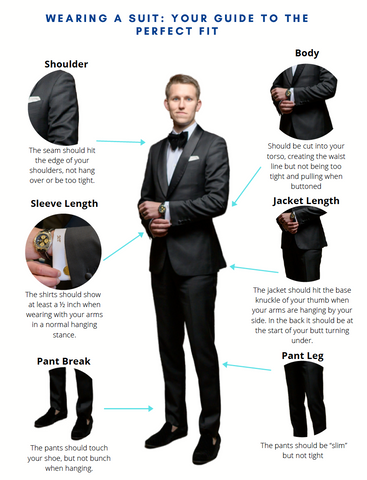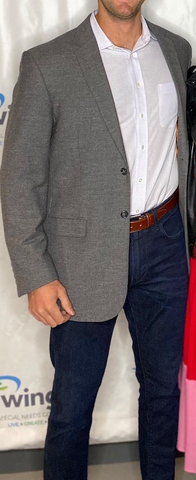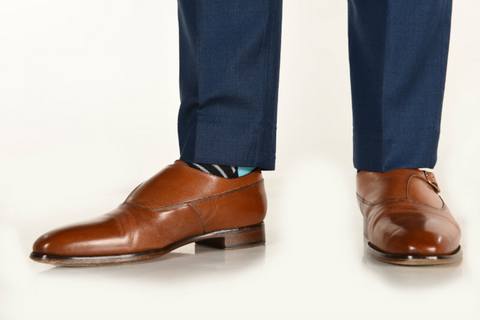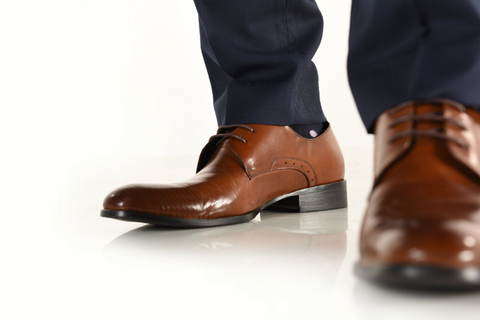A Complete Guide to the Perfect Fit Suit
A Complete Guide to the Perfect Fit Suit
Finding the right fit is hard and takes attention to detail. Fit is the most important aspect when looking at suits, so take the time to get it right. Everyone has various preferences on the fit, but there are a few key things that every suit should have in order to be the right fit. Most of the fit guide is the same for men and women, there are a few differences we will notate below. This is a guide, at the end of the day as long as you feel comfortable the fit is perfect.

To download our fit guide click here.
Shoulders
When men and women buy off the rack the shoulder is one of the most common to not fit properly. You usually have to give up the shoulder to gain the right fit somewhere else. The shoulder should lie flat and the seam of the suit should form where your arm meets your shoulder. The shoulder fit is the hardest to adjust and the most important, don’t buy a piece that does not fit in the shoulders, you’ll never be able to get it to fit properly.

Jacket Length
Jacket length can really change the look and is important when it comes to a proper fit. For a man, the perfect fit, the back should cover your butt, ideally where the butt curves back in towards your thighs. For women this can vary based on preferences- but the suggested fit for the most flattering look is in the back the vent should not quite fully cover your butt, but come about 3/4th the way down. In the front it should hit typically about the thumb knuckle.
The best way to tell if a jacket is the right length is by using your hands. Ann appropriate modern length will hit in the middle of your hand, at about where your thumb joint meets your arms hanging at rest for a man and the thumb knuckle for a woman. 

- Image 1: Incorrect length, the jacket is too long, resulting in a boxy and shorter looking individual
- image 2: Correct length: the same guy with a jacket that fits proper and the length lands at the thumb, Elongated and thinning him out visually
Sleeve Length
If your sleeve length is proper, we should see about a half inch of your shirt cuff beyond your jacket sleeve. It doesn’t have to be exact, but use that as a guideline and make sure some of your shirt cuff shows from your jacket. You should never see the full cuff. If the seam of your cuff shows then your shirt is either too long or your jacket is too short.

Jacket Collar
This is easy to tell if it fits, but finding the reason can be hard.
You want your jacket to rest against your shirt collar without significant gaps in the neck. Generally if you have a gap between the suit collar and the shirt collar you need to make some adjustments in fit so you have the smooth lines similar to the pictures below.
Pant Length or “Break”
The break is the small wrinkle created when your pant cuff hits your shoe. Style can dictate your preference for the amount of break, the more modern look is no break. However, the standard guideline is a small, subtle break. One small crease is usually ideal as the cuff rests on top of your shoe, they need to touch but there shouldn’t be much more than that. For women length is preference depending on shoes you typically wear, but the rules are generally the same for men and women here on length


- Image 1: no break- This is a more modern fit, the pant touches the shoe but does not break at all.
- Image 2: slight break- classic, preferred look. The pant touches the shoe with 1 very slight fold, but not bunched.
Pant Legs
The pants should be “slim” but not tight and the seat drop should not hang too low. There is variance here based on comfort, but the main thing is the be able to move comfortable without fear of ripping your pants, but not so baggy if a gust of wind came through it would carry you.


- Image 1: Correct fit- the pants are slim in the leg, but not tight. This can be adjusted for individuals preference, but should generally be a rule of thumb to avoid the pants making you look larger.
- Image 2: incorrect fit- the pants are too baggy and long making this individual look shorter and larger then he is.
When you’re making investments in suits make sure you’re getting the best fit and putting your best foot forward!
